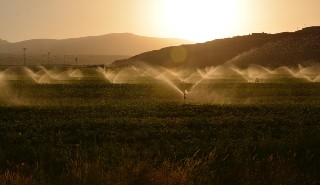Food production at risk from water demand uncertainty
10 June 2022

Estimates of the amount of water needed for agriculture worldwide are ‘unreliable’ and potentially ‘dangerous’ for global water and food security, new research has shown.
A study by an international team of scientists has shown that estimates produced by models used to inform the UN’s Sustainable Development Goals around clean water and sanitation could be up to 100 times lower than the true amount of water needed for irrigation.
The scientists argue that variables such as the size of irrigated areas, changes to evaporation and transpiration by plants due to climate change and the efficiency of irrigation methods must be analysed and integrated into models, or policies instead be more closely based on the perspectives of farmers.
The study was carried out by Princeton University, University of Bergen, University of Arizona, University of Oxford, University of Reading, University of East Anglia, German Aerospace Center, European Centre for Medium-Range Weather Forecasts, Swedish University of Agricultural Sciences and UPF Barcelona School of Management and is published in the journal Nature Communications.
'We are significantly in the dark'
Dr Samuele Lo Piano, a researcher in the School of the Built Environment at the University of Reading and co-author of the study, said: “Water is a vital resource that underpins global peace and all life on Earth, so knowing how much freshwater we have is important. However, current estimates for the volume of freshwater used for irrigated agriculture are unreliable and unfit to guide decision-making.
“Our study revealed the estimates calculated by global models may vary by more than two orders of magnitude. This means the models are misguiding us under an accuracy mirage and it is impossible to know whether we are underestimating or overestimating the impact of irrigation agriculture in the water cycle.
“We are significantly in the dark and pretending we are not is dangerous.”
Irrigated agriculture is the largest consumer of freshwater globally, with the widely accepted estimate being that it uses around 70% of the world’s freshwater.
This estimate is based on global hydrological models that follow a relationship between crop yield and water requirement calculated in the 1950s by irrigation engineers. The estimate feeds into the UN’s World Water Development Reports and the European Commission’s Blueprint to Safeguard Europe’s Water Resources.
The UN’s global goal on clean water and sanitation aims to ensure access to water for the world’s population. Accurate estimations of the amount of water left after irrigation is therefore important both for water security as well as for food production from agriculture.
Sidelined perspectives
Dr Lo Piano said: “We might have to accept that models may not be the best tools to inform policy given the large uncertainties involved around irrigation. Rather than attempt to drive uncertainties away, we should integrate them into the calculations and conduct global uncertainty and sensitivity analysis.
“If estimates still vary too much to reliably guide policy-making, we could look to add the perspectives of traditional irrigators and local farmers, who are currently largely sidelined in favour of outdated assumptions.”
Dr Arnald Puy, lead author from the University of Bergen, said: “We want to increase awareness of the fact that models are not objective constructs, but the consequence of non-unique choices made by their designers. Models that aim at guiding policies, but that have not undergone a systematic assessment of uncertainties and embedded value-laden assumptions, should be seen with suspicion.”

